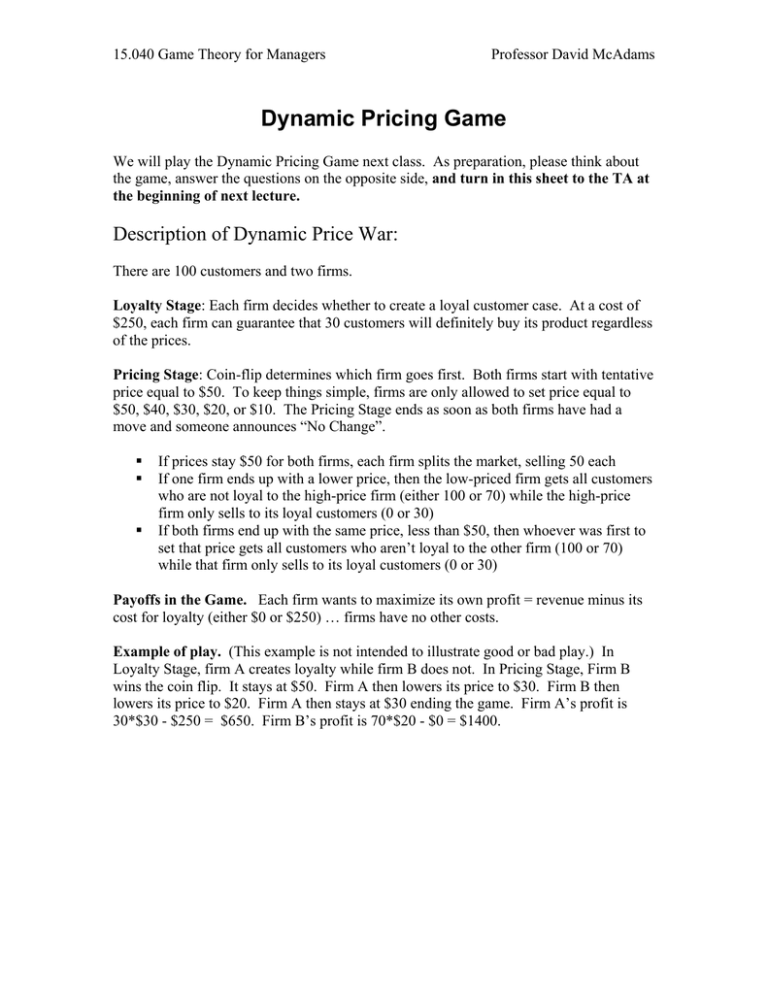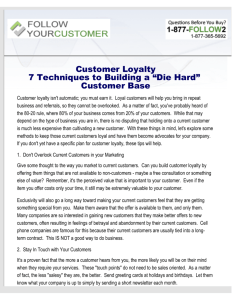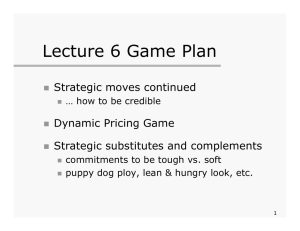Dynamic Pricing Game
advertisement

15.040 Game Theory for Managers Professor David McAdams Dynamic Pricing Game We will play the Dynamic Pricing Game next class. As preparation, please think about the game, answer the questions on the opposite side, and turn in this sheet to the TA at the beginning of next lecture. Description of Dynamic Price War: There are 100 customers and two firms. Loyalty Stage: Each firm decides whether to create a loyal customer case. At a cost of $250, each firm can guarantee that 30 customers will definitely buy its product regardless of the prices. Pricing Stage: Coin-flip determines which firm goes first. Both firms start with tentative price equal to $50. To keep things simple, firms are only allowed to set price equal to $50, $40, $30, $20, or $10. The Pricing Stage ends as soon as both firms have had a move and someone announces “No Change”. If prices stay $50 for both firms, each firm splits the market, selling 50 each If one firm ends up with a lower price, then the low-priced firm gets all customers who are not loyal to the high-price firm (either 100 or 70) while the high-price firm only sells to its loyal customers (0 or 30) If both firms end up with the same price, less than $50, then whoever was first to set that price gets all customers who aren’t loyal to the other firm (100 or 70) while that firm only sells to its loyal customers (0 or 30) Payoffs in the Game. Each firm wants to maximize its own profit = revenue minus its cost for loyalty (either $0 or $250) … firms have no other costs. Example of play. (This example is not intended to illustrate good or bad play.) In Loyalty Stage, firm A creates loyalty while firm B does not. In Pricing Stage, Firm B wins the coin flip. It stays at $50. Firm A then lowers its price to $30. Firm B then lowers its price to $20. Firm A then stays at $30 ending the game. Firm A’s profit is 30*$30 - $250 = $650. Firm B’s profit is 70*$20 - $0 = $1400. 15.040 Game Theory for Managers Professor David McAdams How would you play? What would you do in the following two situations? Please briefly explain your answers. 1. You have invested in Loyal customers, but the other firm has not. They win the coin flip and decide to undercut you with price $40. How would you respond? Why? 2. Neither you nor your opponent has invested in Loyal customers. You win the coin flip. Do you stay at $50 or undercut? If undercut, what price? Why? 3. Which do you plan to do: invest in Loyal customers or not? Your Name: __________________________







